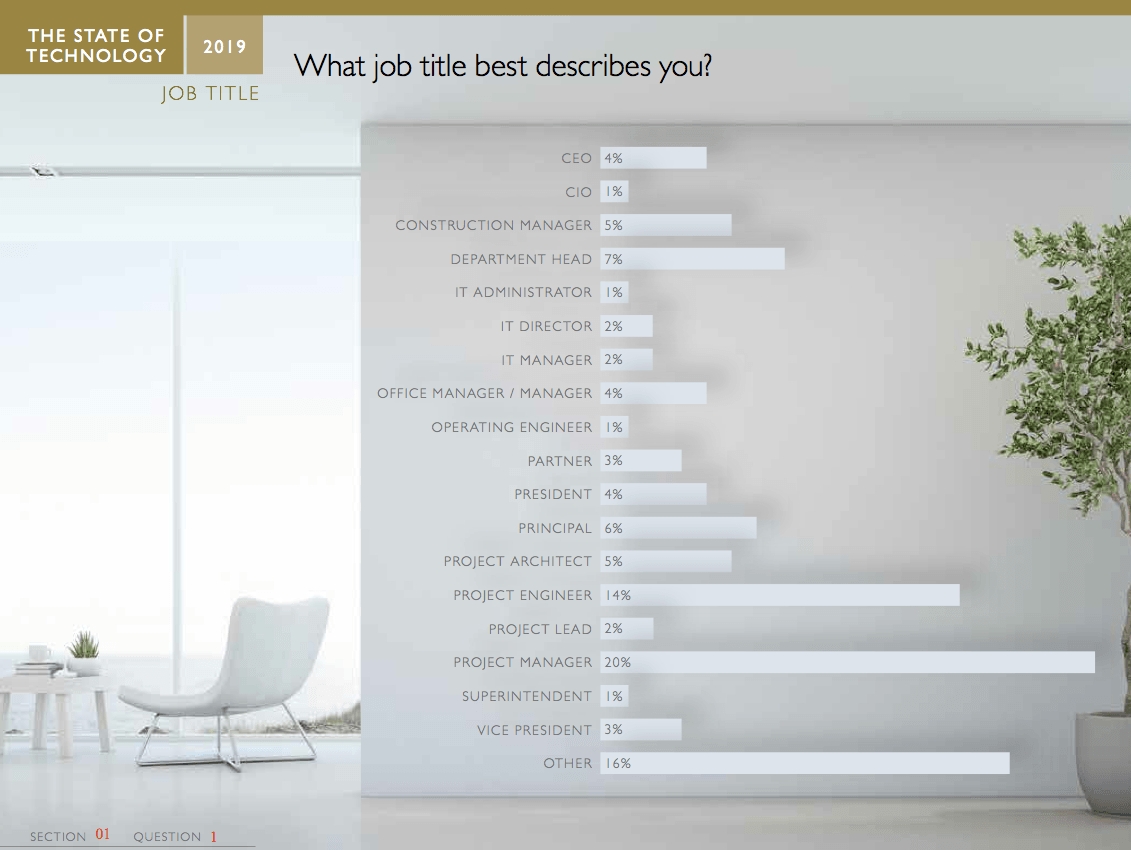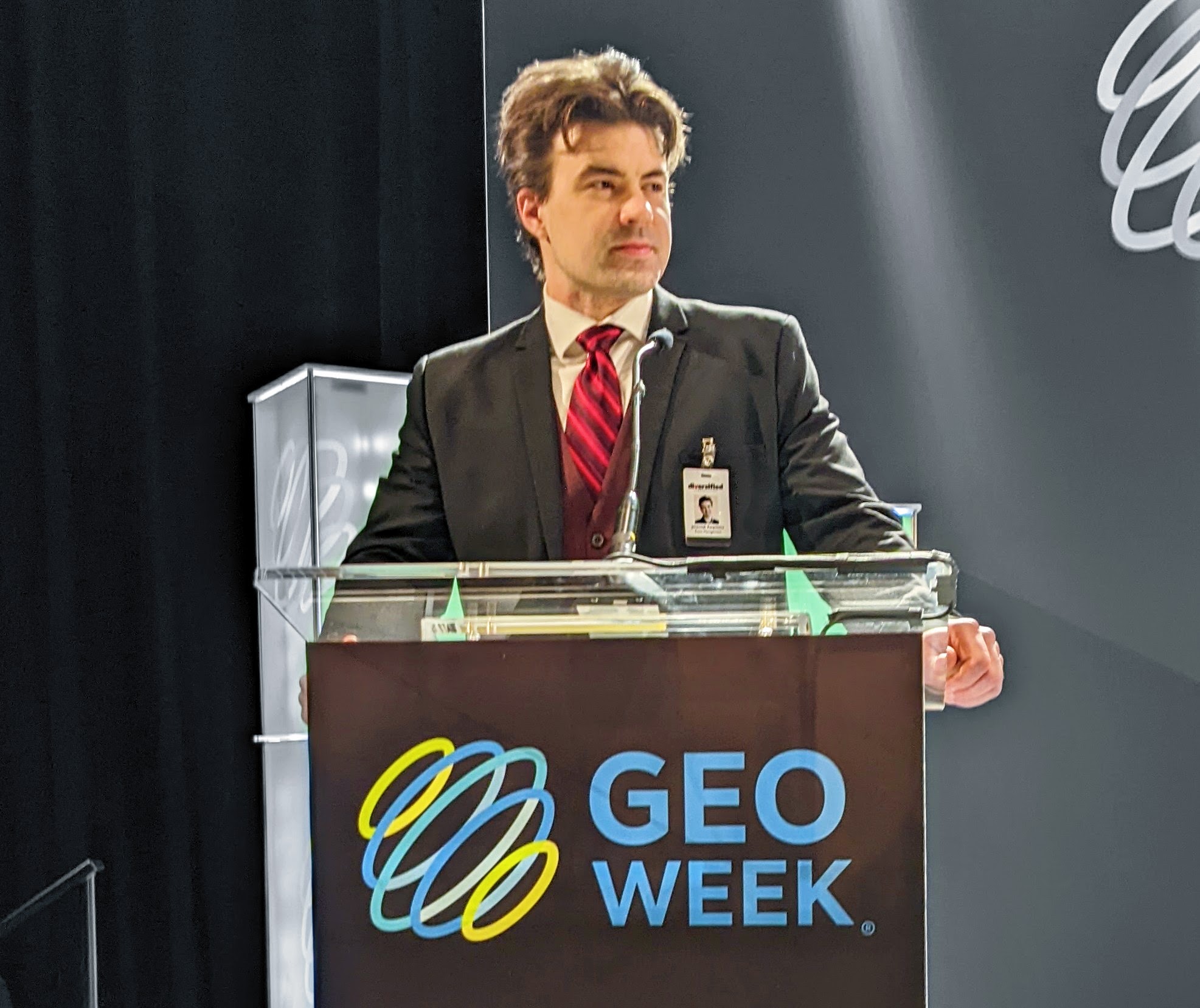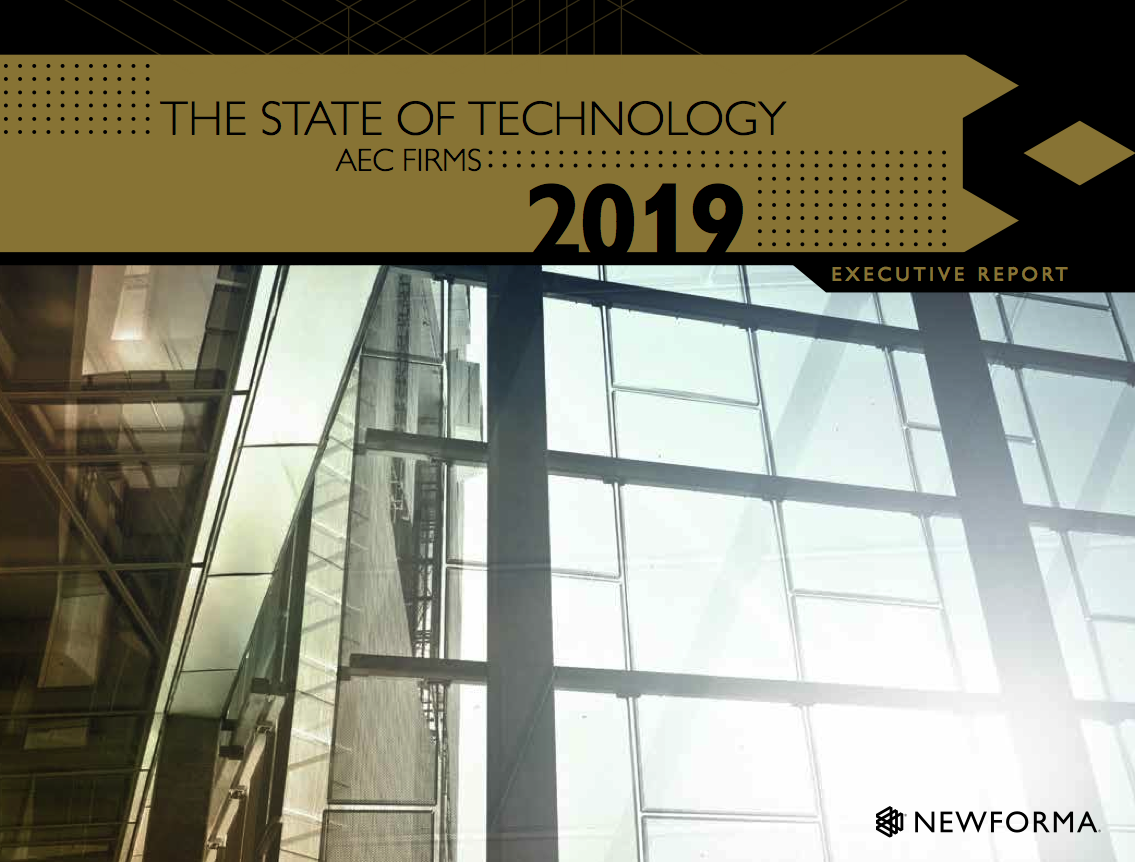Newforma recently released the State of Technology Executive Report, a publication resulting from a national survey polling 1,154 architects, engineers and construction professionals. The Executive Report reveals the top AEC software applications, most common mobile devices staff use in the field, data and file storage preferences, top technology and Project Information Management (PIM) challenges, and the recency of architects, civil and structural engineers, multi-discipline design, and MEP firms being named in a legal dispute.
We recently caught up with Leslie Garrett, PhD, VP of Marketing at Newforma, who developed the survey and oversaw the execution of the Executive Report. We learned why she believes there is a need for this type of data in the AEC profession and how AEC firms can use the Executive Report to help reinforce or guide decision-making – especially the information around AEC software applications most common by type of firm.
Download the 2019 State of Technology in AEC Firms Executive Report here.

Jeremiah Karpowicz: Can you tell us about the genesis of the State of Technology Executive Report? When and how did you recognize the need to explore mobile device preferences, software, file storage, technology challenges and project information challenges of professionals working in AEC?
Leslie Garrett, PhD: I came into this channel from the accounting technology industry. Several years ago, I recognized a need for this type of data in that industry. In 2013 I co-founded the Accounting Firm Operations and Technology (AFOT) Survey and Executive Report. Managing Partners, IT Admin and C-level executives are keenly interested in workflow, tax, audit, bookkeeping, document management, and other types of accounting and tax firm software applications their peers were using. The AFOT Survey and its Report is still running today. Data for the 6th Annual AFOT Survey will publish in an eBook in the coming months.
I approached the concept of building the State of Technology Survey for the AEC industry in a similar fashion. My first move was to scour the internet for a survey or report of this nature where the sample size and methodology gave me confidence the data was a valid representation of the industry nationwide. I found none. AEC professionals should not be moved by a statistic unless they know with confidence it is a valid representation of the entire population – not a subset of, for example, an association member base, a vendor’s customer base, or one readership from a publication. Data from these solo sources may be valid for that group, however they are a subset of the entire population. Furthermore, I know once multiple years of data are collected and presented in this Executive Report, AEC professionals will see trendlines manifest thus providing greater confidence in decision-making around the data points collected in the survey.
As a PhD, I take the aspect of data validity seriously. I built the survey and the team executed its delivery to potential respondents in a way to ensure the data was a valid representation of the U.S. AEC population on a whole. The Executive Report makes it easy for the reader to digest the information and benchmark their firm; the information becomes actionable at-a-glance. We plan on continuing to run this State of Technology AEC Survey annually.
What kind of gaps did you see in terms of the way some of this information was being presented and understood?
Consider the most common ways AEC professionals get educated; they search the internet, follow their association events or newsletters and attend trade shows. Furthermore, AEC professionals may trust their peers’ recommendations over all other sources. This Executive Report gives architectural, civil and structural engineering, multi-discipline and MEP firms the chance to look in the medicine cabinets of hundreds of their peers. Within seconds of paging through the Executive Report the reader will know what their peers are using as the leading AEC software applications, technology and Project Information Management challenges, most preferred ways to store project data, and how likely it is to be named in a legal dispute.
Because of the way in which this survey was marketed (banner ads ran on three industry magazine websites and an email blast to an independent database of 220,000 confirmed AEC professionals), we know the data is valid and an accurate reflection of the entire AEC population in the United States, not a sub-set of the population.
Were there any guiding principles or concepts that you relied on to decide what questions you did or didn’t want to ask? What were some of the factors you considered when assembling the questions for this report?
I wanted to keep the questions focused primarily on AEC software ecosystems and top challenges. I also wanted to ask about the recency of being named in a legal dispute and learn whether the potential for being named in a dispute was more or less-prevalent by type of firm. The differences are revealed in the Report. Additionally, I could not find any national data about this matter.
Ultimately, the Survey and Executive Report were built and executed around with these cornerstones:
- National validity is paramount. I explain how we achieved validity of this survey in the Introduction to the Research, found on Page 5 of the Executive Report. AEC professionals who read about how we achieved validity will – and should – question the validity of every survey written or spoken about in the AEC profession. Data-driven decision-making can only be as sound as the data relied upon when decisions are made.
- Benchmarking should be easy. We present overall results in pie charts, easily digestible at-a-glance, and distinguishable by type of firm. For example, architecture firms prefer iPhones over Android smartphones when in the field. Overall, all firms prefer smartphones over iPads or Android tablets in the field and very few are using laptops when away from the office. Furthermore, do you know how prevalent it is to be named in a legal dispute if you run a civil or structural engineering firm? I didn’t and could not find any data around this point. We asked, “Has your firm been named in a legal dispute?” as our final survey question. The answer, by type of firm, is quite interesting. When you pair the response to this question with firms who indicate “maintaining and preserving an audit trail” as a top technology or Project Information Management challenge, you can imagine risk to the firm elevating substantially. Connecting the data points in this survey provides actionable insight not possible without a resource of this type. It is in connecting these data points where firms will glean the greatest value or added confidence with decision-making.
- Trendlines are powerful. Two years of data is interesting, three years of data will build confidence in futures projections. We are committed to run multiple years of this survey to provide AEC professionals with trendlines that can impact technology planning.
What surprised you most about the results of the survey?
I was surprised by the tight grouping of top six technology and PIM challenges. There are a few clear leaders as top challenges; however, the next four challenges are only separated by a few percentage points. Furthermore, I was very curious about the data around the recency of the firm being named in a legal dispute.

Is it possible to talk about “workflow” at a broad level? That term might mean something different to every organization and individual, so how have you been able to discuss the topic in a way that makes sense in a general but still specifically relevant manner?
The survey covers “project workflows,” which is broad, however, firms that identify with this challenge – the survey reveals 40 percent of all firms do. Project teams are unique, brought together one time to build unique structures. It is easy to presume why it is difficult to develop repeatable processes and project workflows.
In general terms, project workflows impact the design and delivery of any project therefore it is understandable why so many firms recognize this as a challenge –or pain point. AEC software applications that ease project information management can make it easier to access and organize project data, collaborate with project team members, and manage construction projects from inception through delivery, and beyond.
In more specific terms, not all AEC project information management software applications are equal, and if project workflows are a top challenge at your firm, it’s crucial to get things right. The best software application for this matter will solve project workflow pain points without disrupting the way people work. This software should not force teams to change their workflow. A key factor enabling this attribute the software’s connector strategy. We know Newforma can’t provide a software that does everything—there are other tools out there that are very good at what they do, like Bluebeam for viewing and PDF mark-up and MS Outlook for email. Newforma has resolved project workflows by connecting to applications like Bluebeam and MS Outlook and Exchange Server which allows everyone on the project team to continue to use the tools they prefer which makes processes repeatable for the architect’s firm using Newforma software -or any type of firm in the AEC profession using Newforma software. Newforma connectors make project workflows processes repeatable without changing how project teams work.
One of the more telling results from the survey was associated with the high use of smartphones in the field. This result led to the conclusion that companies should place a higher priority focus on the deployment of software applications with mobile apps, but do you think there are any complications with doing so as a result of users in the field using their personal smartphones versus company property?
This depends on the firm, its policies, and the mobile app – also, the sensitivity of the tasks being handled in the field.
Tying this data point back into actionable insight, the survey revealed administrative workload is a top technology challenge. If mobile apps on smartphones being used in the field allow tasks to be handled immediately while on a site visit, most would view this as a time-savings because this task would not be revisited when back at the office.
Email management is an issue for companies in every industry across the world, but do you think there are any specific challenges with it that AEC professionals deal with? How have you seen those challenges most effectively resolved?
Email is popular because it is easy, mobile and immediate. Unfortunately, any project can generate 10s of thousands of emails and thousands of files as attachments. Knowing with certainty the project team is working off the most current set of drawings, and who approved what, and when can be difficult if not impossible, without the right technology in place. Project teams are varied; connecting software applications and indexing emails and attachments wherever they reside and making those emails searchable from a unified dashboard is the only way to resolve this issue.
We joke – and it is truly no joke – about design and build, then litigate. Email and attachments to email can be a project minefield for AEC firms for many reasons. For example, if approval happened via email and search is labor-intensive causing added administrative workload, time and resources are wasted. If approvals are buried in emails or not found, the burden of proof will remain with the AEC firm until proven otherwise.
Broadly speaking, what does this report tell you about where AEC is at and where it needs to go?
Project workflows and administrative workload and tasks are some of the highest-rated challenges across the board. Trend lines will be revealed in future years, allowing one to more confidently answer the question regarding where the industry is headed.
Broadly speaking, AEC firms need to identify their top technology and PIM challenges in their existing state and then define the desired state of where they want to be. Mapping the milestones to achieve the desired state and then moving the firm from its current state to that first milestone will result in a step in the right direction.
Based on what you’ve showcased in this report, what sort of questions should companies and professionals be asking if they’re struggling with a technology challenge?
The first step to resolving a challenge is defining the challenge(s) and what the desired state of resolution is. I recommend downloading the Executive Report and distributing it to your firm’s leadership team before your next meeting. Advance to pages 40 and 42 of the Report to learn about the technology challenges other firms of a similar type are struggling with. This may fuel or more easily ramp into a high-value discussion around the technology challenges in your firm.
After the challenge(s) is defined, begin your investigation into possible solutions. If you cannot change a factor, explore options that make that factor less of an issue, or a non-issue. For example, project teams are unique, comprised of people from multiple types of businesses (architects, engineers, contractors, owners). If project workflow is a challenge because of the team members and disparate software applications firms are using, you will need to investigate and perhaps adopt an AEC software application that unifies processes through a central dashboard enabling all parties to work and leave data where it resides, without changing how your firm prefers to handle a process.
The State of Technology Executive Report is available for immediate download, here.






